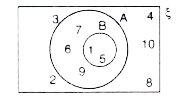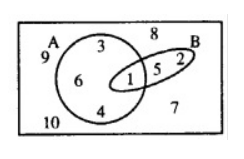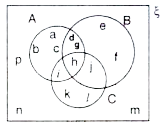Draw a Venn-diagram to show the relationship between sets A and B , such that A⊆B. Now shade the region representing :
(i) A∪B, (ii) B'∩A, (iii) A∩B, (iv) (A∪B)'
To solve the problem, we need to draw a Venn diagram to illustrate the relationship between sets A and B, where A is a subset of B (denoted as A⊆B). Then, we will shade the regions representing the specified set operations.
1. Draw the Universal Set Box:
- Start by drawing a rectangle to represent the universal set, which contains all possible elements.
2. Draw the Venn Diagram:
- Inside the rectangle, draw two circles. Label the larger circle as set B and the smaller circle inside it as set A. This visually represents that A is a subset of B.
3. Shade the Region for A∪B:
- The union of sets A and B, denoted A∪B, includes all elements that are in A, in B, or in both. Since A is a subset of B, shading the entire area of circle B will represent A∪B.
4. Shade the Region for B′∩A:
- The complement of B, denoted B′, includes all elements not in B. The intersection B′∩A represents the elements that are both in the complement of B and in A. Since A is entirely within B, there are no elements that satisfy this condition. Therefore, this region will not be shaded (it is empty).
5. Shade the Region for A∩B:
- The intersection of sets A and B, denoted A∩B, includes all elements that are in both A and B. Since A is entirely within B, the shaded area will be the entire area of circle A.
6. Shade the Region for (A∪B)′:
- The complement of A∪B includes all elements not in either A or B. Since we have already established that A∪B is equal to B, the complement (A∪B)′ will be the area outside circle B, which is the part of the universal set that does not include B.
Summary of Shaded Regions:
- A∪B: Shade the entire area of circle B.
- B′∩A: No shading (empty region).
- A∩B: Shade the entire area of circle A.
- (A∪B)′: Shade the area outside circle B.
- Start by drawing a rectangle to represent the universal set, which contains all possible elements.
- Inside the rectangle, draw two circles. Label the larger circle as set B and the smaller circle inside it as set A. This visually represents that A is a subset of B.
- The union of sets A and B, denoted A∪B, includes all elements that are in A, in B, or in both. Since A is a subset of B, shading the entire area of circle B will represent A∪B.
- The complement of B, denoted B′, includes all elements not in B. The intersection B′∩A represents the elements that are both in the complement of B and in A. Since A is entirely within B, there are no elements that satisfy this condition. Therefore, this region will not be shaded (it is empty).
- The intersection of sets A and B, denoted A∩B, includes all elements that are in both A and B. Since A is entirely within B, the shaded area will be the entire area of circle A.
- The complement of A∪B includes all elements not in either A or B. Since we have already established that A∪B is equal to B, the complement (A∪B)′ will be the area outside circle B, which is the part of the universal set that does not include B.
- A∪B: Shade the entire area of circle B.
- B′∩A: No shading (empty region).
- A∩B: Shade the entire area of circle A.
- (A∪B)′: Shade the area outside circle B.
Topper's Solved these Questions
Similar Questions
Draw a Venn-diagram to show the relationship between two overlapping sets A and B. Now shade the region representing :
(i) A∩B, (ii) A∪B, (iii) B-A
View SolutionTwo sets A and B are such that A∩B=π. Draw a Venn-diagram to show the relationship between A and B. Shade the region representing :
(i) A∪B, (ii) (A∪B)', (iii) B-A, (iv) B∩A'
View SolutionFrom the given diagram find:
(i) A∪B
(ii) A'∩B
(iii) A-B
(iv) B-A
(v) (A∪B)'

View SolutionProve (A∩B)'=(A'∪B')
View SolutionUse the given Venn-diagram to find:
(i) B-A
(ii) A
(iii) B'
(iv) A∩B
(v) A∪B

View SolutionDraw the venn diagram to represent
(i) A∩(B−A)'<br>(ii)A∪B(B∩A)'
View SolutionIf A and B are two sets such that A⊆B, then find
(i) A∪B
(ii) A∩B.
View SolutionFrom the given diagram, find:
(i) A', (ii) B', (iii) A'∪B', (iv) (A∩B)'
Is A'∪B'=(A∩B)' ?

View SolutionUse the given diagram to find:
(i) A∪(B∩C)
(ii) B−(A−C)
(iii) A-B
(iv) A∩B'
is A∩B'=A−B?

View SolutionFrom the adjoining Venn diagram , find the following sets :

(i) A (ii) B (III) A∪B (iv) A∩B
View Solution
